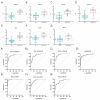A Novel Methylation Marker NRN1 plus TERT and FGFR3 Mutation Using Urine Sediment Enables the Detection of Urothelial Bladder Carcinoma
- PMID: 36765573
- PMCID: PMC9913436
- DOI: 10.3390/cancers15030615
A Novel Methylation Marker NRN1 plus TERT and FGFR3 Mutation Using Urine Sediment Enables the Detection of Urothelial Bladder Carcinoma
Abstract
Background: Aberrant DNA methylation is an early event during tumorigenesis. In the present study, we aimed to construct a methylation diagnostic tool using urine sediment for the detection of urothelial bladder carcinoma, and improved the diagnostic performance of the model by incorporating single-nucleotide polymorphism (SNP) sites.
Methods: A three-stage analysis was carried out to construct the model and evaluate the diagnostic performance. In stage I, two small cohorts from Xiangya hospital were recruited to validate and identify the detailed regions of collected methylation biomarkers. In stage II, proof-of-concept study cohorts from the Hunan multicenter were recruited to construct a diagnostic tool. In stage III, a blinded cohort comprising suspicious UBC patients was recruited from Beijing single center to further test the robustness of the model.
Results: In stage I, single NRN1 exhibited the highest AUC compared with six other biomarkers and the Random Forest model. At the best cutoff value of 5.16, a single NRN1 biomarker gave a diagnosis with a sensitivity of 0.93 and a specificity of 0.97. In stage II, the Random Forest algorithm was applied to construct a diagnostic tool, consisting of NRN1, TERT C228T and FGFR3 p.S249C. The tool exhibited AUC values of 0.953, 0.946 and 0.951 in training, test and all cohorts. At the best cutoff value, the model resulted in a sensitivity of 0.871 and a specificity of 0.947. In stage III, the diagnostic tool achieved a good discrimination in the external validation cohort, with an overall AUC of 0.935, sensitivity of 0.864 and specificity of 0.895. Additionally, the model exhibited a superior sensitivity and comparable specificity compared with conventional cytology and FISH.
Conclusions: The diagnostic tool exhibited a highly specific and robust performance. It may be used as a replaceable approach for the detection of UBC.
Keywords: DNA methylation region; SNPs; diagnostic tool; urothelial bladder carcinoma.
Conflict of interest statement
The authors declare no conflict of interest.
Figures





Similar articles
-
Urine Cellular DNA Point Mutation and Methylation for Identifying Upper Tract Urinary Carcinoma.Cancers (Basel). 2022 Jul 21;14(14):3537. doi: 10.3390/cancers14143537. Cancers (Basel). 2022. PMID: 35884598 Free PMC article.
-
Clinical Significance of Hotspot Mutation Analysis of Urinary Cell-Free DNA in Urothelial Bladder Cancer.Front Oncol. 2020 May 19;10:755. doi: 10.3389/fonc.2020.00755. eCollection 2020. Front Oncol. 2020. PMID: 32509577 Free PMC article.
-
Diagnostic potential of TERT promoter and FGFR3 mutations in urinary cell-free DNA in upper tract urothelial carcinoma.Cancer Sci. 2019 May;110(5):1771-1779. doi: 10.1111/cas.14000. Epub 2019 Apr 7. Cancer Sci. 2019. PMID: 30887605 Free PMC article.
-
Novel urine-based DNA methylation biomarkers for urothelial bladder carcinoma detection in patients with hematuria.Arab J Urol. 2023 May 14;21(4):248-257. doi: 10.1080/2090598X.2023.2208492. eCollection 2023. Arab J Urol. 2023. PMID: 38178946 Free PMC article.
-
Toward urinary cell-free DNA-based treatment of urothelial carcinoma: a narrative review.Transl Androl Urol. 2021 Apr;10(4):1865-1877. doi: 10.21037/tau-20-1259. Transl Androl Urol. 2021. PMID: 33968675 Free PMC article. Review.
Cited by
-
Recent advances on gene-related DNA methylation in cancer diagnosis, prognosis, and treatment: a clinical perspective.Clin Epigenetics. 2025 May 5;17(1):76. doi: 10.1186/s13148-025-01884-2. Clin Epigenetics. 2025. PMID: 40325471 Free PMC article. Review.
-
Evaluation of Fibroblast Growth Factor Receptor 3 (FGFR3) and Tumor Protein P53 (TP53) as Independent Prognostic Biomarkers in High-Grade Non-muscle Invasive Bladder Cancer.Cureus. 2024 Jul 31;16(7):e65816. doi: 10.7759/cureus.65816. eCollection 2024 Jul. Cureus. 2024. PMID: 39219882 Free PMC article.
-
Unleashing the potential of urine DNA methylation detection: Advancements in biomarkers, clinical applications, and emerging technologies.Curr Urol. 2025 Sep;19(5):295-302. doi: 10.1097/CU9.0000000000000291. Epub 2025 Jul 19. Curr Urol. 2025. PMID: 40894279 Free PMC article.
-
Urine-Based Biomarker Test Uromonitor® in the Detection and Disease Monitoring of Non-Muscle-Invasive Bladder Cancer-A Systematic Review and Meta-Analysis of Diagnostic Test Performance.Cancers (Basel). 2024 Feb 11;16(4):753. doi: 10.3390/cancers16040753. Cancers (Basel). 2024. PMID: 38398144 Free PMC article. Review.
-
Urinary DNA methylation-based risk stratification model to triage patients for repeat transurethral resection of bladder tumours.Clin Transl Med. 2024 Jan;14(1):e1549. doi: 10.1002/ctm2.1549. Clin Transl Med. 2024. PMID: 38251828 Free PMC article. No abstract available.
References
-
- Sbizzera M., Descotes F., Arber T., Neuville P., Ruffion A. Bladder cancer detection in patients with neurogenic bladder: Are cystoscopy and cytology effective, and are biomarkers pertinent as future diagnostic tools? A scoping review. World J. Urol. 2022;40:1897–1913. doi: 10.1007/s00345-022-03943-2. - DOI - PubMed
-
- Hentschel A., Beijert I., Bosschieter J., Kauer P., Vis A., Lissenberg-Witte B., van Moorselaar R., Steenbergen R., Nieuwenhuijzen J. Bladder cancer detection in urine using DNA methylation markers: A technical and prospective preclinical validation. Clin. Epigenetics. 2022;14:19. doi: 10.1186/s13148-022-01240-8. - DOI - PMC - PubMed
Grants and funding
LinkOut - more resources
Full Text Sources

